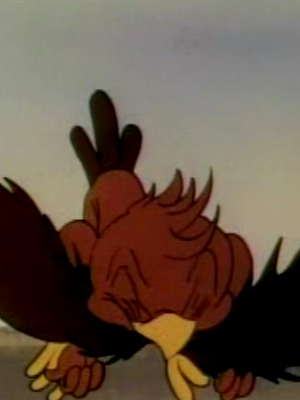













 http://www.cartoonthrills.org/blog/01Principles/antics/ElmerBugsantics.mov
http://www.cartoonthrills.org/blog/01Principles/antics/ElmerBugsantics.mov
 big space between anticipation drawing and Bugs jumping up and turning
big space between anticipation drawing and Bugs jumping up and turning then slowing out of the turn and jump with some close drawings on their way into the run pose
then slowing out of the turn and jump with some close drawings on their way into the run pose



 big space from the up and turn pose to the first running pose
big space from the up and turn pose to the first running pose




It's good to know about anticipations, but it's also good to not use them at random or as a formula.
Not every action needs an antic. Some do. They shouldn't all be done the same way.


Avoid too much anticipation and always doing it the same way
There is a style of of anticipation in Canada and Korea that drives me nuts. I wish I had an example to show, but they have a tendency to always do the same pose for the anticipation and it's way over done. The character will hunch down, his shoulders come up and the head sinks way down. Then they spring past the final pose they are aiming at and settle into it. The same way every time. They use this for every action and it becomes very obvious and monotonous.Now there is the Flash style of antic and overshoot which is even more monotonous and robotic. http://www.xsheet.net/pictures/6teen.mp4
http://www.xsheet.net/pictures/6teen.mp4
 http://www.xsheet.net/pictures/6teen.mp4
http://www.xsheet.net/pictures/6teen.mp4All principles can be abused or overused, when done without thinking or by rote.
Antics, like your other drawing and animation tools, should be customized to the action and story. You should learn them in the basic ways first, but then get to the point to where you can feel when one is appropriate and how to vary them and customize them to the scene, character and story. Once you get good and confident, you shouldn't have to calculate which tools to use for what scenes. It should just come naturally. A good animator uses a lot of variety in how he does things. A formulaic one does it the same way every time.
Avoid repetitive actions, poses and expressions - customize your actions to the story
On The Ripping Friends, I used to see actions done with this formulaic repetitive same antic for every pose, so I started adding my own customized antics in the layouts to break up the monotony.So then what happened was the animators added MORE anticipations to anticipate the anticipations. The result was the characters would spring and bounce and boing from pose to pose as if they had the hiccups.
You can also see this formulaic overuse of antics and overshoots in many modern cartoons - especially the prime time ones that move like robots on springs. It's what I call trick animation. Always doing everything using the same tricks the same way. That may smooth out the actions, but it's unnatural and monotonous. It doesn't bring any soul, believability or uniqueness of life to anything. It feels phony.
Making fun of stock principles
Sometimes I make fun of principles in my cartoons and do them stupidly on purpose. There was a scene in Stimpy's Invention where Stimpy was reacting to Ren being happy with his new happy helmet.
I wanted to accent Stimpy's final pose with a big antic first. The way it was staged, combined with Stimpy's simple construction didn't allow for a normal antic, so I just squashed his whole body down like an accordion and sprung him up into his final excited pose.

 Thanks to Dragan for putting this sequence together for me!
Thanks to Dragan for putting this sequence together for me!They animated it at Carbunkle and made it work perfectly. From then on, I tried putting lots of weird inbetweens and quick poses into scenes that you wouldn't really see unless you freeze framed the animation. Doing this in context makes your scenes more natural and rich with life and spontaneity.
Of course before you get to that point, you have to learn it the standard way first and just get it to work smoothly.
More fun applications of classic principles still performed their necessary functions but gave the animation a fresher, funnier and less predictable feeling. I'll show you some variety of antics in another post.
2 GOALS OF ANTICIPATIONS
1) To Create Space - between where you start and where you are going to go. By moving away from where you are going to go you give yourself more distance for the action to travel in. This makes the action quicker; it gives it an accent.



2) To Draw the Audience Attention - to let you know something is going to happen, instead of just letting it happen and have you miss it
Thanks also to Tara Sheppard, Brendan Brody and Mark Peel for your donations yesterday!










